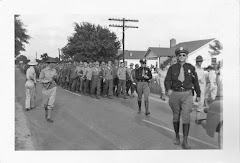


The current issue of Museum News from the Aliceville Museum carries a story about an unusual reenactment that took place in Poland and eastern Germany this past January. Beginning at 11:00 p.m. on January 27, a group of "Kriegie Kids" set out to cover a 60 mile journey in four days. They were honoring and remembering a forced journey made by their fathers and grandfathers in 1945, as World War II was grinding to a close.
"Kriegies" refers to American soldiers who were prisoners of war in Germany. (The German word Krieg means "war" in English.) When word reached Poland that the Russians were advancing into German territory, Adolf Hitler ordered the evacuation of thousands of Allied prisoners from camps like Stalag Luft III so he could continue to hold them as hostages and bargaining chips. These prisoners were ordered on a forced march in sub-freezing weather.
During the reenactment, the "Kriegie Kids" met a man named Hans Burkhardt in the town of Spremberg. Burkhardt, who was eleven at the time of the original march, remembered seeing tired, mostly barehanded men marching in the freezing weather. He says his family offered food and water to several of them.
Borkhardt had a watch and a carved placque that belonged to a deceased friend who had been a German POW at a camp in Arkansas. This friend, Ervin Vorssatz, had carved the placque during his POW time in Arkansas. Borkhardt presented these items to the Kriegie Kids.
On March 17, 2009, former Allied POW Lieutenant Colonel Edward M. Bender (USAAFR, retired) and his daughter Miriam Larson, presented the watch and the placque to the Aliceville Museum. They are now on display.
For more information about the Kriegie Kids and their experience, please visit the website http://cloudcorridor.blogspot.com/.
"Kriegies" refers to American soldiers who were prisoners of war in Germany. (The German word Krieg means "war" in English.) When word reached Poland that the Russians were advancing into German territory, Adolf Hitler ordered the evacuation of thousands of Allied prisoners from camps like Stalag Luft III so he could continue to hold them as hostages and bargaining chips. These prisoners were ordered on a forced march in sub-freezing weather.
During the reenactment, the "Kriegie Kids" met a man named Hans Burkhardt in the town of Spremberg. Burkhardt, who was eleven at the time of the original march, remembered seeing tired, mostly barehanded men marching in the freezing weather. He says his family offered food and water to several of them.
Borkhardt had a watch and a carved placque that belonged to a deceased friend who had been a German POW at a camp in Arkansas. This friend, Ervin Vorssatz, had carved the placque during his POW time in Arkansas. Borkhardt presented these items to the Kriegie Kids.
On March 17, 2009, former Allied POW Lieutenant Colonel Edward M. Bender (USAAFR, retired) and his daughter Miriam Larson, presented the watch and the placque to the Aliceville Museum. They are now on display.
For more information about the Kriegie Kids and their experience, please visit the website http://cloudcorridor.blogspot.com/.






